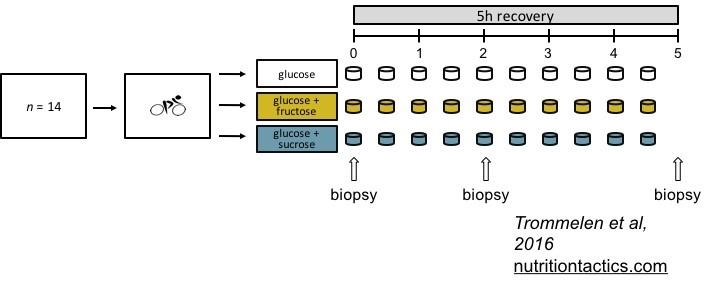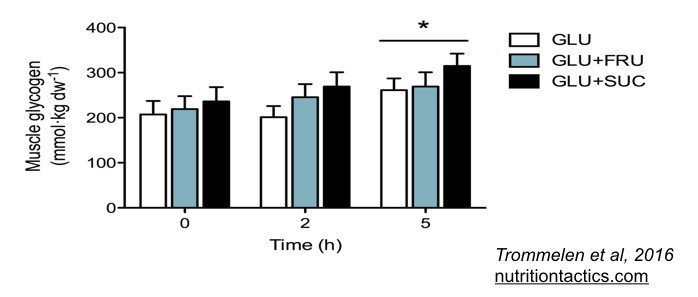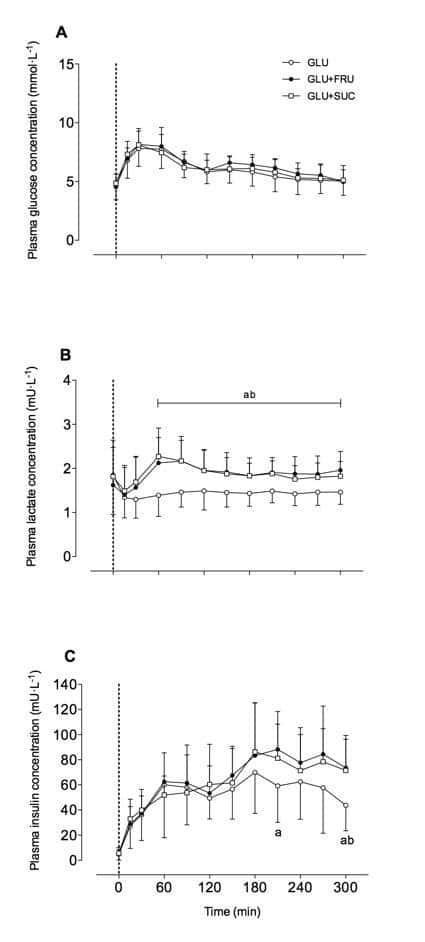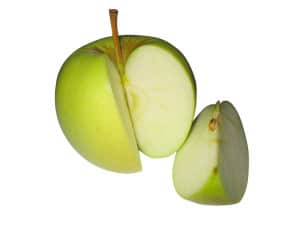This guest post is written by Jorn Trommelen
Fructose has a bad rep.
Fructose and high fructose corn syrup are blamed for the obesity epidemic. Therefore, many athletes avoid fructose like the plague.
But is the fructose scare justified? Or could fructose actually be beneficial for athletes?
I [Jorn] just published a study on this topic, let me tell you all about it!
Fructose Coingestion Does Not Accelerate Postexercise Muscle Glycogen Repletion
Background
Glycogen repletion is one of the most important factors that determines recovery time for endurance athletes.
Carbohydrate ingestion post-exercise helps to restore glycogen, and high amounts are needed for optimal glycogen resynthesis(1).
But there’s a limit.
At a certain point, more carbohydrates do not further stimulate glycogen resynthesis.
We speculated that at a certain dose, the gut reached its maximal rate of carbohydrate absorption.
More carbohydrates would just mean that they accumulated in the gut. Indeed, in previous research we saw that athletes get severe stomach complaints once carb intake gets very high.
However, fructose is absorbed via a different route in the gut than most other carbohydrates.
So we hypothesized that the total rate of carbohydrate absorption would be higher with a glucose/fructose mixture, compared to a glucose solution alone.
And this higher rate of absorption would provide more carbs to the muscle to be used for glycogen resysnthesis.
The Subjects
We studied 14 well-trained cyclist in their mid 20’s-mid 30’s (age: 28±6 y).
Exercise test
Each test day started with a glycogen depleting cycling protocol*.
Nutritional intervention
Participants received a standardized dinner the night before ( 55% CHO, 27% Fat, and 18% Protein).
We tested 3 different isocaloric recovery formulas:
- glucose
- glucose + fructose
- glucose + sucrose
Sucrose splits into glucose and fructose in the gut, so it’s alternative fructose source.
The drinks were provided every 30 min

Measurements
During the recovery period, we measured plasma glucose, plasma insulin, plasma lactate, muscle glycogen content and stomach complaints.
The Data
Muscle glycogen content
All 3 treatments increased muscle glycogen content at 5 hours post workout during the recovery period. However, all 3 treatments were equally effective, indicating no additional benefit from fructose.

Blood Chemistry
Interestingly, the groups that had glucose plus either fructose or sucrose (which is glucose and fructose) had increases in blood lactate and insulin levels compared to just glucose alone, yet there were no apparent differences in blood glucose levels.

Stomach complaints
When fructose or sucrose was in the formula, subjects experienced much less stomach complaints.
This suggests that our theory about better carbohydrate absorption (and thus less carb accumulation up in the gut) was correct.
Discussion
How do we explain that muscle glycogen resynthesis was not higher in the glucose/fructose mix treatment if our data also indicate that it did improve carbohydrate absorption?
It seems that the liver converted much of the absorbed fructose into lactate. Therefore, the muscle did not get the chance to use fructose for muscle glycogen resynthesis.
This study has taught us that replacing a part of glucose drink with fructose has no negative effect on muscle glycogen repletion.
However, it does lower stomach complaints.
In addition, previous research has shown that a glucose/fructose mixture is more effective at liver glycogen resynthesis compared to glucose (Decombaz, 2011) .
So replacing a part of your glucose drink with fructose only has positive effects (on gastrointestinal parameters)!
The wrap up
The optimal protocol for glycogen resynthesis is:
- 1.2 g/kg/h-1 carbohydrate (2:1 glucose fructose mixture) provided every 30 min.
This:
- maximizes muscle glycogen resynthesis
- maximizes liver glycogen resynthesis
- minimizes stomach complaints
Note that you might need to work up slowly to this high doses over a couple of weeks if you have a sensitive gut.
Jorn Trommelen is a PhD candidate in Muscle Metabolism. Follow him on Twitter, and read more practical posts like this on his blog Nutrition Tactics
* “This muscle glycogen depletion protocol started with a 10 min warm-up period at 50% WMAX workload. Thereafter, subjects were instructed to cycle 2 min block periods at alternating workloads of 90% and 50% WMAX, respectively. This was continued until subjects were no longer able to complete the 2 min blocks at 90% WMAX. That moment was defined as the inability to maintain cycling speed at 60 rpm. At that moment, the high-intensity blocks were reduced to 80% WMAX. Again, subjects had to cycle until they were unable to complete a 2 min block at 80% WMAX, after which the high-intensity blocks were reduced to 70% WMAX. Subjects were allowed to stop when pedalling speed could not be maintained at 70% WMAX.”
Italics throughout this article are additions by the executive director, Brad Dieter

